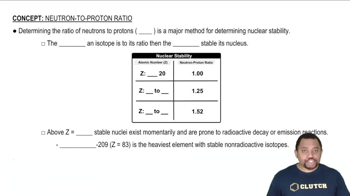Here are the essential concepts you must grasp in order to answer the question correctly.
Half-life
Half-life is the time required for half of the radioactive nuclei in a sample to decay. For Uranium-238, this period is approximately 4.47 billion years. Understanding half-life is crucial for estimating the age of geological samples, as it allows us to calculate how many half-lives have passed based on the ratio of parent isotopes (U-238) to daughter isotopes (Pb-206).
Recommended video:
Radioactive decay
Radioactive decay is the process by which unstable atomic nuclei lose energy by emitting radiation, resulting in the transformation of the original element into a different element or isotope. In this case, Uranium-238 decays into Lead-206 through a series of intermediate isotopes. This concept is essential for understanding how the initial amount of U-238 relates to the amount of Pb-206 present in the rock sample.
Recommended video:
Rate of Radioactive Decay
Isotope ratio
The isotope ratio compares the quantities of different isotopes of an element in a sample. In this scenario, the ratio of Uranium-238 to Lead-206 is used to determine the age of the rock. By knowing the initial amount of U-238 and the amount of Pb-206 produced from its decay, we can apply the half-life to calculate how long the decay process has been occurring, thus estimating the rock's age.
Recommended video:




